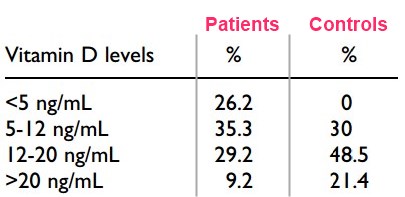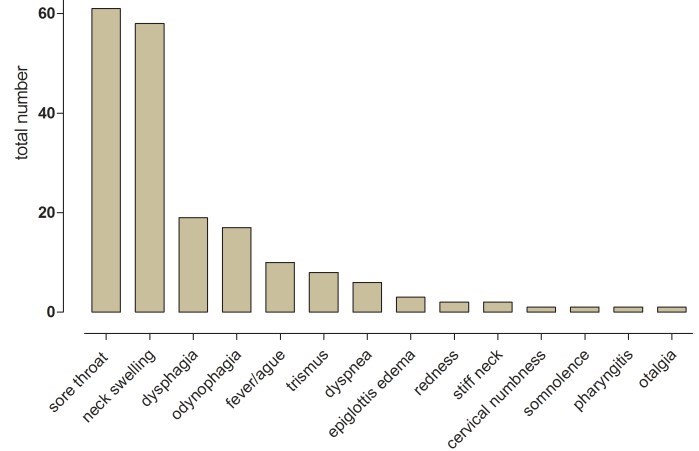Infections and low vitamin D - many studies
Are Vitamin D Levels Associated With Risk of Deep Neck Infection? - Sept 2019
Ear Nose and Throat Journal https://doi.org/10.1177/0145561319865498
Mustafa Sıtkı Gozeler, MD, Muhammed Sedat Sakat, MD, Korhan Kilic, MD, ...

Deep neck infection (DNI) refers to infections in spaces created by superficial and deep cervical fascia around the muscles and organs in the neck. Vitamin D is highly important for an effective immune system. Vitamin D receptors (VDR) have been identified in immune system cells, and particularly in T and B lymphocytes, macrophages, and dendritic cells. Vitamin D deficiency is thought to result in impaired immune response, decreased leukocyte chemotaxis, and an increased disposition to infection. The purpose of this study was to investigate whether vitamin D deficiency is an underlying occult factor in the development of DNI. Sixty-five patients aged 6 to 90, diagnosed with DNI, and 70 healthy age- and sex-compatible cases were included in the study. Serum levels of calcium, phosphorus, parathyroid hormone, and 25-hydroxy vitamin D (25(OH)D) were determined in each case. 25-hydroxy vitamin D levels above 20 ng/mL were regarded as normal, 12 to 20 ng/mL as insufficient, 5 to 12 ng/mL as deficient, and less than 5 ng/mL as severely deficient.
Mean serum 25(OH)D levels were
10.4 (6.2) ng/mL in the patient group and
15.5 (6.4) ng/mL in the control group (P < .01).
This difference was statistically significant (P < .01). Vitamin D was within normal limits in 9.2% (n = 6) of cases in the study group, insufficient in 29.2% (n = 19), deficient in 35.3% (n = 23), and severely deficient in 26.2% (n = 17). The equivalent values in the control group were 21.4% (n = 15), 48.5% (n = 34), 30% (n = 21), and 0% (n = 0). Serum 25(OH)D levels were significantly lower in patients with DNI compared to the healthy cases; 25(OH)D levels may be a factor in the development of DNI.
📄 Download the PDF from Vitamin D Life
Deep neck infections: A single-center analysis of 63 cases - Sept 2017
Med Oral Patol Oral Cir Bucal. 2017 Sep; 22(5): e536–e541, online 2017 Aug 16. doi: 10.4317/medoral.21799
Philipp Kauffmann,corresponding author1 Robert Cordesmeyer,1 Markus Tröltzsch,1 Christian Sömmer,1,2 and Rainer Laskawi3
Background and Purpose
With the use of antibiotic therapy, the incidence of deep neck infections has decreased in recent decades. The aim of this investigation was to review the clinical course and the management of deep neck infections in our department, compare them to the experiences of the common literature and identify predisposing factors for lethal complications.
Material and Methods
In this single-center analysis, 63 patients with deep neck infections were treated surgically. The following clinical data were analyzed and compared: age, gender, laboratory data, spatial manifestation, therapeutic modalities, comorbidities, length of hospitalization and complications.
Results
There was a predominance of male patients (58.7%) and a mean age of 57.9 years. The most common symptoms at diagnosis were sore throat (96.8%) and neck swelling (92.0%). Cardio/pulmonary diseases and diabetes mellitus were the most common comorbidities. There was a significantly longer hospital stay for patients with diabetes mellitus. The most common manifestation was a parapharyngeal abscess in 24 patients (38.1%), followed by peri-/retrotonsillar infections in 19 patients (30.2%). In 29 patients, a multiple space infection was observed, with a significantly longer duration of hospitalization and a higher rate of complications. The main life-threatening complication was the development of airway obstruction in 20 patients (31.7%), who all received a tracheostomy. The duration of hospitalization for patients with complications was significantly longer.
Conclusions
Close attention must be paid to the management of patients with deep neck infections, especially patients with diabetes mellitus and cardio/pulmonary diseases or patients with multiple space infections.
📄 Download the PDF from Vitamin D Life
Deep Neck Infection Symptoms - Sept 2017
1. of infections with a symptom (not %)

Vitamin D Life - Infections
Fact Many infections are associated with low vitamin D
10 percent of all women had after-birth infections – majority had low vitamin D (PhD) – 2019
Helicobacter pylori infection and low vitamin D – many studies
Urinary Tract Infection in children 4.8 X more likely if low Vitamin D – meta-analysis Feb 2019
Joint replacement infection associated with low vitamin D – April 2014
The interplay between vitamin D and viral infections – Jan 2019
Tuberculosis 3X more likely if less than 12 ng of Vitamin D - meta-analysis Sept 2019
Fact Many infections are treated by Vitamin D
Infection fighting ability increased with 5,000 IU Vitamin D daily – April 2015
Tuberculosis -100 percent cure rate with 10,000 IU of vitamin D daily – RCT 2006
Fact Many infections are prevented by higher levels of Vitamin D
Additional 4 ng of vitamin D reduced chance of infection by 7 percent – June 2011
Half the risk of Influenza -A in infants taking 1200 IU of vitamin D for 4 months – RCT Jan 2018
Half as much chronic kidney disease infection if supplement with Vitamin D – 2018
Viral infection reduced 90 percent with 2000 IU of vitamin D – Dec 2010
Many Infectious diseases (virus) treated and prevented by Vitamin D – review July 2009
Apparently Low vitamin D levels are both a cause and a result of severe infections
Unknown Can Vitamin D treat and prevent Deep Neck Infections?
Unknown Does the genes limit vitamin D from getting to deep neck tissues
Upper respiratory infection associated with poor Vitamin D Receptor – Oct 2018
Certain types of Tuberculosis are 2X more likely with a poor Vitamin D Receptor – April 2019
The risk of 43 diseases at least double with poor Vitamin D Receptor as of Oct 2019
Vitamin D Life - Immunity category:
{include}
232 Vitamin D pages contain INFECTION or INFECTIOUS in title (Sept 2024)
{LIST()}
